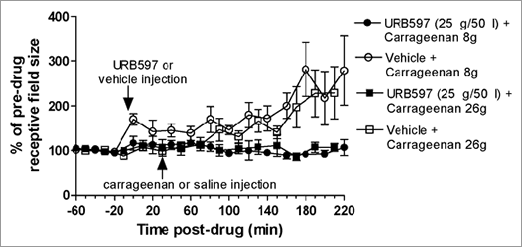113P Brighton
Winter Meeting December 2007 |
Inhibition of FAAH attenuates expansion of peripheral receptive fields of dorsal horn neurones following hind-paw inflammation
Devi Rani Sagar, David Kendall, Victoria Chapman
University of Nottingham, Nottingham, United Kingdom
Previously we have demonstrated that inhibition of fatty acid amide hydrolase (FAAH) with the inhibitor URB597 attenuates carrageenan-induced changes in hind-paw weight bearing (Robinson et al., 2006) and increases levels of endocannabinoids in the hind-paw (Richardson et al., 2007). The aim of the present study was to investigate the neuronal mechanisms underlying the analgesic effects of URB597 by determining the effects of URB597 on evoked neuronal responses and receptive field expansion of spinal neurones in a model of inflammatory pain.
Extracellular recordings of convergent dorsal horn (DH) neurones (Laminae V and VI) were made in anaesthetised (1.5 % isoflurane in 66 % N2O / 33 % O2) male Sprague Dawley rats (250-300 g) (Elmes et al., 2004). Effects of an intraplantar pre-administration (30 min prior) of URB597 (25 μg/50 μl) or vehicle (3% Tween80 in saline) on mechanically-evoked (8-100g) responses of DH neurones was studied in carrageenan (2 %) inflamed rats. In a separate group of rats, peripheral receptive fields of DH neurones on the hind-paw were mapped using innocuous (8 g) and noxious (26 g) stimuli before and after carrageenan (2 %) injection. Effects of intraplantar pre-administration (30 min prior) of URB597 on carrageenan-induced expansion of peripheral receptive fields were determined.

Figure 1. Effects of intraplantar pre-administration of URB597 on carrageenan-induced expansion of peripheral receptive fields of DH neurones (URB597 n=6; vehicle n=7). Data are expressed as mean % of pre-drug receptive field size ±SEM. Statistical analyses were performed using area under the curve analysis and a Mann Whitney test.
URB597 did not alter mechanically-evoked (8-100 g) responses of DH neurones in carrageenan inflamed rats (n=6 neurones in 6 rats for each group), it did however, significantly reduce the expansion of peripheral receptive fields of DH neurones (8 g p<0.01) and (26 g p<0.05) evoked responses compared to effects of vehicle in carrageenan treated rats (Figure 1). These data suggest that effects of peripheral blockade of FAAH on nociceptive behaviour in the carrageenan model of inflammatory pain may arise as a result of an inhibition of the sensitisation of DH neurones and the associated expansion of peripheral receptive fields.
Elmes et al., (2004) Eur J Neurosci., 20(9):2311-20.
Robinson et al., (2006) www.pa2online.org/abstracts/Vol4Issue2abst093P.pdf
Richardson et al., (2007) University of Nottingham Joint Focused BPS meeting Spring 2007. P033
|


